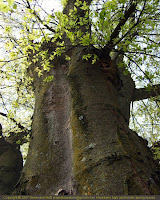Celtis occidentalis, Sugarberry, Nettletree

This common hackberry tree grows in Hopkinsville, Kentucky, on the Catholic church property. Its bark is fairly smooth with occasional warty areas and raised creases.
All of the hackberry trees I've seen around here have bark similar to this. None of them have bark that would be described as ridged.
Thus, I was surprised to read this sentence about hackberries in The Trees of North America by Alan Mitchell: "In Central Park [New York City], the trees have smooth gray bark, but it is normally well covered in dark, abrupt, broken ridges 1 in. thick."
The Audubon field guide shows hackberry bark that is similar to that in the photo above, but Trees & Shrubs of Kentucky has a photo of a hackberry trunk with ridged bark. More research in other texts yields more conflicting descriptions of the bark's texture.
I did notice that the word "warty" appears in most of the descriptions. Even the ridges were described as warty.
Probably there are regional variations in the bark, but Carl Settergren and R.E. McDermott in Trees of Missouri suggest another explanation. "Bark: Grayish with warty projections, smoother on more vigorous trees."

 "The power to recognize trees at a glance without examining their leaves or flowers or fruit as they are seen, for example, from the car-window during a railroad journey, can only be acquired by studying them as they grow under all possible conditions over wide areas of territory. Such an attainment may not have much practical value, but once acquired it gives to the possessor a good deal of pleasure which is denied to less fortunate travelers."
"The power to recognize trees at a glance without examining their leaves or flowers or fruit as they are seen, for example, from the car-window during a railroad journey, can only be acquired by studying them as they grow under all possible conditions over wide areas of territory. Such an attainment may not have much practical value, but once acquired it gives to the possessor a good deal of pleasure which is denied to less fortunate travelers."
1 comments -- please add yours:
I just identified a hackberry tree from a forest jaunt in Missouri. Thanks for this post. The projections on my tree were quite interesting, with many multiple layered "warty projections". :0)
Post a Comment